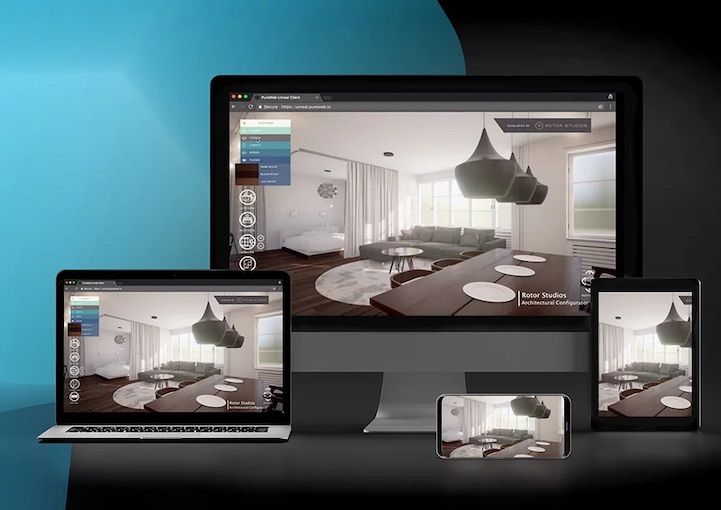Why the Future of Business is in Interactive 3D Cloud Rendering and Streaming

Activities like watching Netflix movies and listening to Spotify on phones and tablets are part of our everyday lives, so it’s no surprise that the future is leading us into more content streaming.
Over the past decade, streaming has gone from a nascent technology to standard practice, thanks to increasing internet speeds and more advanced content platforms and services. The gaming industry generally blazes the path that the rest of the 3D world follows, and right now, it’s moving toward more immersive and interactive forms of streaming.
With the launch of Google Stadia — a subscription service for streaming games through the cloud, similar to those offered by Steam, Nvidia, and PlayStation — the tech industry has made it clear where the future of gaming lies. For businesses in industries such as automotive and architecture, this trend in the gaming industry is especially noteworthy.
A 2019 Global Market Insights report estimates that the 3D rendering market will hit $6 billion by 2025, up from $1.5 billion in 2018. As mobile continues to obtain parity with the desktop and streaming further matures, organizations of all sizes will be able to tap into similar technology and create high-quality 3D renderings, configurators, and simulators that can be delivered on a massive scale, regardless of local GPU power.
The availability of this technology will help businesses looking to create high-quality training courses online or significantly improve their e-commerce offerings. But the businesses using these tools have often been hampered by inefficient publishing and delivery methods that include expensive dedicated hardware, limited remote capabilities, and delayed real-time collaboration.
Real-time 3D streaming for business
Whether you’re selling cars or condos, customizable, photorealistic models and 3D configurators that are streamed online can be a powerful way to engage customers and increase conversions. If you haven’t run into them online yet, you’ve likely seen their pale imitations that use photography and a single viewing angle to give you a sense of what a product looks like.
Read Next: What is real-time 3D rendering (and why the future of digital depends on it)
3D rendering provides a hyper-realistic experience that allows a user to fully customize a product and see how it interacts with the real world, all with the same fluidity you’d expect while playing a modern video game. This impressive real-time 3D rendering technology is made available through gaming engines like Unity and Unreal Engine.
The challenge isn’t so much in creating an interactive and immersive 3D model, but in creating one that can be streamed seamlessly and without latency. Doing it well requires a handful of processes working together perfectly in order to deliver an optimal experience. For most companies, building such a system with the right in-house experts at the helm is virtually impossible. But there are real-time cloud streaming services that can help.
Cloud streaming across all kinds of devices
Cloud streaming services offer paths forward for companies that want to stream data-intensive interactive 3D technology all over the globe, regardless of computing power. Companies of all sizes and resources can deliver their interactive 3D models everywhere — from powerful workstations to budget tablets and smart phones — without the need to create new departments and invest in dedicated servers to accomplish it.
PureWeb makes it possible for remote users to play with high-fidelity renderings at home, taking the traditional sales floor and showroom and transporting them to a person’s living room. And 3D rendering can offer a variety of environments where a product can be tested and ways to share customized creations with others.
For companies that have dabbled with WebGL or Unreal’s Pixel Streaming, some of this may sound familiar. However, PureWeb’s cloud platform and fully managed service goes beyond these in a few ways.
WebGL is an excellent open standard that doesn’t require plug-ins, but it is best used for simple, stripped-down 3D models. It has a few obstacles that make it a no-go for many businesses. The technology has limits on fidelity and has trouble with latency, which are deal breakers for companies needing to deliver a seamless interactive 3D experience to customers. It also doesn’t play well with mobile devices, cutting out an important part of the customer base.
Related Read: Deploying real-time 3D - WebGL vs cloud rendering?
Pixel Streaming, meanwhile, is limited to the Unreal Engine projects and can only be distributed to a wide audience if you have your own cloud infrastructure set up to do so. For most companies, this isn’t feasible. With PureWeb’s cloud rendering service, however, that scalability is built-in.
Although the upfront costs of interactive 3D cloud streaming offered by PureWeb are higher than these alternatives, the return on investment is significantly better. That’s not just compared to lower-fidelity options, but also to other marketing strategies, such as pay-per-click search and social media ads. And an advanced, interactive experience is going to bring more customers to a website because people can actually visualize, play around with, and create the real-world value of the product they’re considering.
How PureWeb delivers the ultimate scalable solution for customers
Businesses looking to take advantage of interactive 3D streaming content need the backing of experts with the right resources to effectively implement photoreal 3D streaming models.
PureWeb, with 15 years of experience in the streaming field, is able to offer that expertise with a proven infrastructure that can stream 3D renderings and 3D configurators across the globe to devices of every size — as well as realistic and interactive 3D simulators for any online learning and gamified training module created in Unreal or Unity.
If you’re looking to get into the future of streaming, either for e-commerce or for in-house training, PureWeb is here to get you where you need to be. Our fully managed solution can not only scale to handle whatever traffic you throw at it, but it can also easily integrate into existing e-commerce funnels and learning management tools.
Our proprietary cloud platform links cloud infrastructure to streaming applications and offers secure and stable high-performance, interactive 3D streaming. We support the design process with collaborative visualizations and can deploy on-premise or in the cloud. PureWeb goes beyond other offerings, supporting advanced features like real-time ray tracing while still pushing optimum efficiency.
The future of business is real-time streaming. By letting the experts handle the infrastructure, you can focus on creating 3D applications that will wow your audience, anytime, anywhere.
To find out more about PureWeb and get a demo, contact us.


